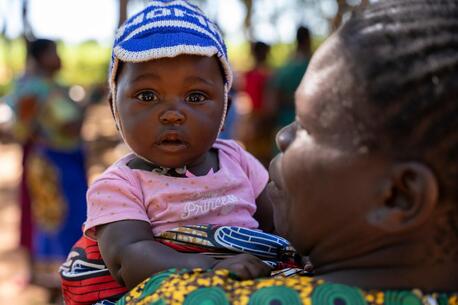
Food Access and Child Trafficking
Millions of children around the world lack access to food, making them vulnerable to human traffickers.
Every year the United Nations celebrates World Food Day in order to "promote worldwide awareness and action for those who suffer from hunger." The day also draws attention to Sustainable Development Goal #2, which seeks to achieve #ZeroHunger by 2030. Eradicating world hunger would have monumental effects on the world, one of which being that it would bring us a step closer to curbing another one of the world's horrors – child trafficking.
Traffickers, such as pimps, take any opportunity to exploit a void that exists in a child’s life, and one such void is the inability to regularly access food. There are over 6 million children in the U.S. who are food insecure and 1.4 million more in Nigeria, Somalia, South Sudan, and Yemen who are threatened by famine. Though food insecurity and famine are different, they share in the unfortunate reality that they drive families to desperation which child traffickers can then exploit.
Food insecurity is the condition of limited or uncertain access to adequate food, and it is a reality that Americans in every U.S. county experience. Though programs such as SNAP - better known as food stamps - do exist, they only provide an average of $1.40 per meal, per person. This is hardly enough to purchase most foods, let alone maintain a well-balanced diet.
U.S. teenagers interviewed by the Urban Institute about their experience with food insecurity revealed that they would often forego meals so that younger siblings could have enough to eat. The insufficient food supply then placed the older siblings' focus on finding a next meal, rather than on school or future job prospects. This hunger and the ensuing desperation left the teens with few options – all of which result in long-term implications that are difficult, if not impossible, to reverse.
When teens who steal for survival are caught, it is reflected in their criminal records. This criminal record further restricts job opportunities, forcing food-deprived teens to turn to alternatives in the "informal" job sector. In this sector, the lack of regulation increases the likelihood that seemingly legitimate job offers are actually just exploitative scams. Once a child accepts an exploitative scam offer, the ensuing trauma and a lack of income perpetuates the vulnerabilities that made the child susceptible in the first place. Other children turn to sex traffickers out of desperation because they offer resources in exchange for exploitation. In fact, 65% of those surveyed related stories of sexual exploitation, or “survival sex,” in exchange for food or money to purchase food. Due to the fact that the teens are under the age of 18, they cannot consent to sex and thus this is considered child sex trafficking.
Lack of food access is clearly not just a U.S. phenomenon, and it makes people in all parts of the world susceptible to trafficking. This is especially relevant in parts of Africa right now, where millions are facing famine. Famine is an extreme lack of food where starvation, death, and destitution are evident, more than 30% of people are acutely malnourished, and two out of every 10,000 people die from starvation. These conditions force families and individuals to flee their homes in search of opportunities elsewhere, and are part of the reason that there are more children on the move now than ever before. These children frequently find themselves unable to pursue legal migration pathways and are thus reliant upon on criminal networks. This places them at an increased risk of exploitation. In fact, a recent UNICEF report titled Harrowing Journeys found that along certain routes to Europe, 80% of youth and adolescents on the move reported exploitation.
We have seen the devastating effects of famine before, making it all the more urgent to act now on behalf of the children facing it today. Previously, between October 2010 and April 2012, Somalia experienced a famine and food crisis wherein an estimated 258,000 people died. In an attempt to flee the famine, many placed their faith in smugglers who made promises of a better life elsewhere. However, after traveling hundreds of miles, stuffed in vans full of strangers, countless children were sold into exploitation. Trafficked individuals often lack legal documentation and funds to pay for basic necessities, making escaping exploitation all the more difficult.
In order to meaningfully tackle the issue of child trafficking, it is essential to trace it to its underlying causes. A lack of food access is one such cause that impacts millions of children around the world today, and it is a reality that we have the power to change. Here are some ways to take action:
· Trick or Treat for UNICEF to protect children from famine.
· Challenge yourself to live a SNAP, or food stamp, budget.
· Ask your elected officials to protect vulnerable children in the U.S. and abroad.
· Purchase a UNICEF Kid Power Band and unlock ready-to-use therapeutic food for malnourished children with every step you take.
· Learn the signs to spot trafficking when it happens.
Together, we can ensure that no child remains invisible or voiceless because of circumstance.
HOW TO HELP
There are many ways to make a difference
War, famine, poverty, natural disasters — threats to the world's children keep coming. But UNICEF won't stop working to keep children healthy and safe.
UNICEF works in over 190 countries and territories — more places than any other children's organization. UNICEF has the world's largest humanitarian warehouse and, when disaster strikes, can get supplies almost anywhere within 72 hours. Constantly innovating, always advocating for a better world for children, UNICEF works to ensure that every child can grow up healthy, educated, protected and respected.
Would you like to help give all children the opportunity to reach their full potential? There are many ways to get involved.





